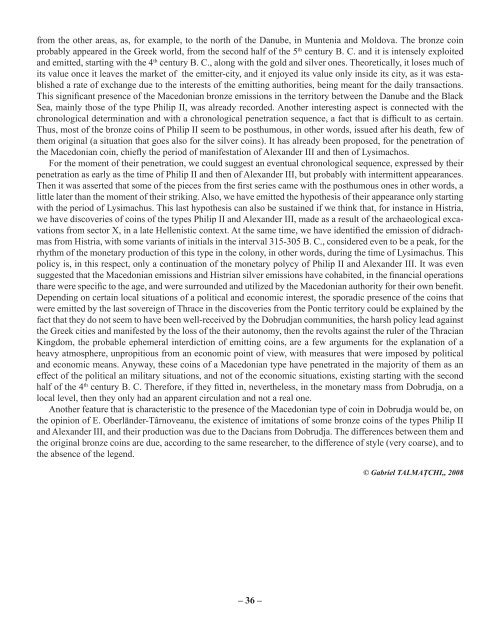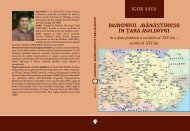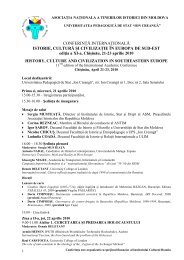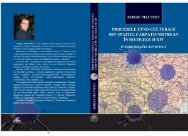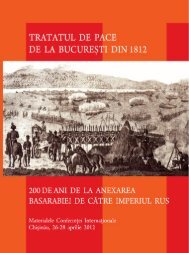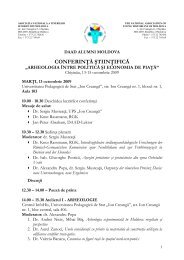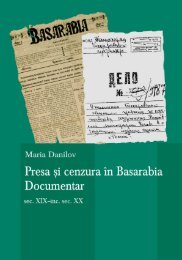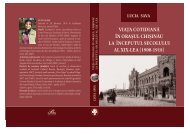Publicatie cu continut integral - Asociatia Tinerilor Istorici din Moldova
Publicatie cu continut integral - Asociatia Tinerilor Istorici din Moldova
Publicatie cu continut integral - Asociatia Tinerilor Istorici din Moldova
Create successful ePaper yourself
Turn your PDF publications into a flip-book with our unique Google optimized e-Paper software.
from the other areas, as, for example, to the north of the Danube, in Muntenia and <strong>Moldova</strong>. The bronze coin<br />
probably appeared in the Greek world, from the second half of the 5 th century B. C. and it is intensely exploited<br />
and emitted, starting with the 4 th century B. C., along with the gold and silver ones. Theoretically, it loses much of<br />
its value once it leaves the market of the emitter-city, and it enjoyed its value only inside its city, as it was established<br />
a rate of exchange due to the interests of the emitting authorities, being meant for the daily transactions.<br />
This significant presence of the Macedonian bronze emissions in the territory between the Danube and the Black<br />
Sea, mainly those of the type Philip II, was already recorded. Another interesting aspect is connected with the<br />
chronological determination and with a chronological penetration sequence, a fact that is diffi<strong>cu</strong>lt to as certain.<br />
Thus, most of the bronze coins of Philip II seem to be posthumous, in other words, issued after his death, few of<br />
them original (a situation that goes also for the silver coins). It has already been proposed, for the penetration of<br />
the Macedonian coin, chiefly the period of manifestation of Alexander III and then of Lysimachos.<br />
For the moment of their penetration, we could suggest an eventual chronological sequence, expressed by their<br />
penetration as early as the time of Philip II and then of Alexander III, but probably with intermittent appearances.<br />
Then it was asserted that some of the pieces from the first series came with the posthumous ones in other words, a<br />
little later than the moment of their striking. Also, we have emitted the hypothesis of their appearance only starting<br />
with the period of Lysimachus. This last hypothesis can also be sustained if we think that, for instance in Histria,<br />
we have discoveries of coins of the types Philip II and Alexander III, made as a result of the archaeological excavations<br />
from sector X, in a late Hellenistic context. At the same time, we have identified the emission of didrachmas<br />
from Histria, with some variants of initials in the interval 315-305 B. C., considered even to be a peak, for the<br />
rhythm of the monetary production of this type in the colony, in other words, during the time of Lysimachus. This<br />
policy is, in this respect, only a continuation of the monetary polycy of Philip II and Alexander III. It was even<br />
suggested that the Macedonian emissions and Histrian silver emissions have cohabited, in the financial operations<br />
thare were specific to the age, and were surrounded and utilized by the Macedonian authority for their own benefit.<br />
Depen<strong>din</strong>g on certain local situations of a political and economic interest, the sporadic presence of the coins that<br />
were emitted by the last sovereign of Thrace in the discoveries from the Pontic territory could be explained by the<br />
fact that they do not seem to have been well-received by the Dobrudjan communities, the harsh policy lead against<br />
the Greek cities and manifested by the loss of the their autonomy, then the revolts against the ruler of the Thracian<br />
Kingdom, the probable ephemeral interdiction of emitting coins, are a few arguments for the explanation of a<br />
heavy atmosphere, unpropitious from an economic point of view, with measures that were imposed by political<br />
and economic means. Anyway, these coins of a Macedonian type have penetrated in the majority of them as an<br />
effect of the political an military situations, and not of the economic situations, existing starting with the second<br />
half of the 4 th century B. C. Therefore, if they fitted in, nevertheless, in the monetary mass from Dobrudja, on a<br />
local level, then they only had an apparent cir<strong>cu</strong>lation and not a real one.<br />
Another feature that is characteristic to the presence of the Macedonian type of coin in Dobrudja would be, on<br />
the opinion of E. Oberländer-Târnoveanu, the existence of imitations of some bronze coins of the types Philip II<br />
and Alexander III, and their production was due to the Dacians from Dobrudja. The differences between them and<br />
the original bronze coins are due, accor<strong>din</strong>g to the same researcher, to the difference of style (very coarse), and to<br />
the absence of the legend.<br />
– –<br />
© Gabriel TAlMAţChI,, 2008


